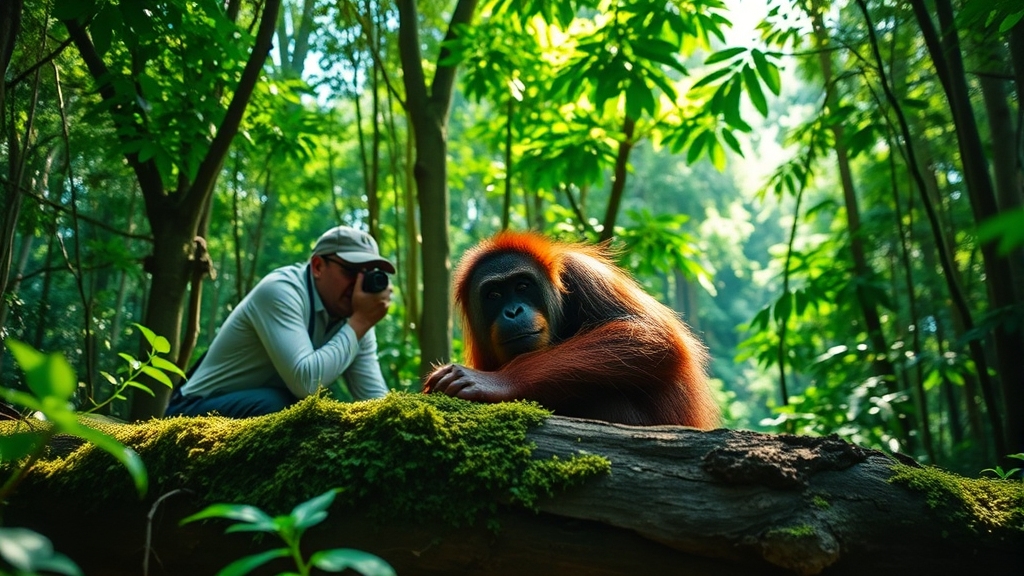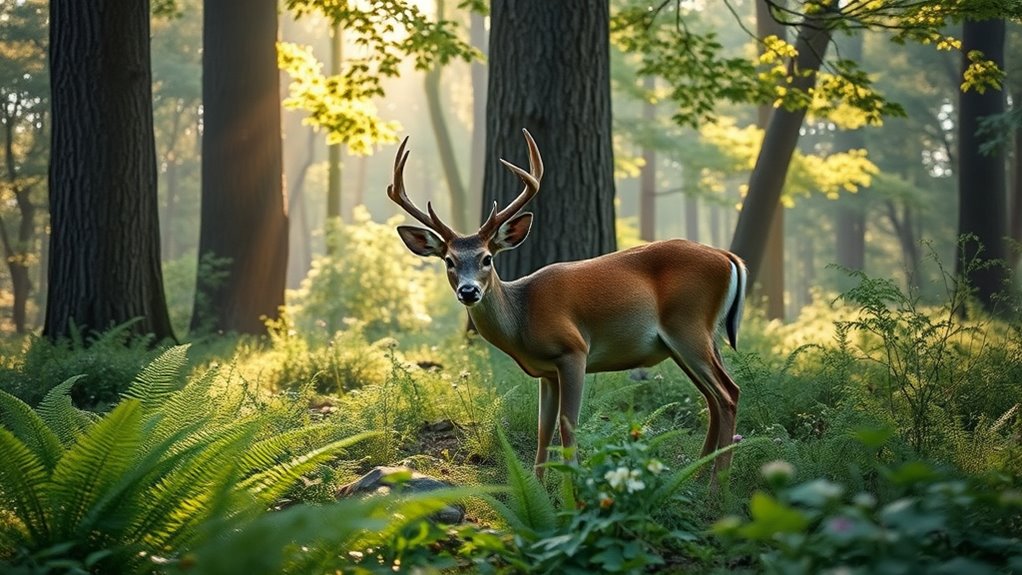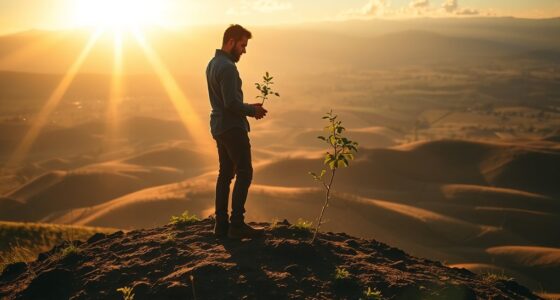To practice ethical wildlife photography, always respect animals and their habitats by keeping a safe distance with long lenses. Avoid manipulating scenes through baiting or calls, and be patient to capture genuine moments. Make certain your actions don’t disturb natural behaviors or cause stress, and follow local regulations. By prioritizing the animals’ well-being and understanding ecological contexts, you help protect wildlife and promote conservation. Continue exploring how to photograph responsibly without harm.
Key Takeaways
- Use long lenses to maintain a safe distance, minimizing stress and disturbance to wildlife.
- Avoid baiting, calls, or artificial attractants to preserve animals’ natural behaviors.
- Respect wildlife habitats and private property, seeking permission and following regulations.
- Ensure photographs accurately reflect natural behaviors, avoiding manipulation or sensationalism.
- Prioritize animal welfare and habitat preservation over capturing perfect shots, supporting conservation efforts.

Wildlife photography offers a mesmerizing way to connect with nature, but it also comes with responsibilities. When you’re out capturing images of animals in their natural habitats, your actions can have a significant impact on their well-being and the environment. Practicing ethical photography isn’t just about avoiding legal trouble; it’s about respecting wildlife and promoting conservation efforts. Your choices can influence how others see and understand these creatures, so it’s vital to prioritize wildlife conservation and adhere to photography ethics at every step.
Wildlife photography combines beauty with responsibility—respect animals and their habitats to promote conservation and ethical imaging.
First, always remember that your presence can cause stress to animals. Approaching too closely or making sudden movements can disturb their natural behaviors, potentially leading to abandonment of nests or increased vulnerability to predators. To minimize this, use long lenses that allow you to shoot from a safe distance. This way, you avoid disrupting their routine while still capturing stunning images. Respecting their space isn’t just considerate—it’s essential for their survival. Every time you respect wildlife boundaries, you contribute to the broader effort of wildlife conservation by setting a positive example and encouraging responsible behavior among other photographers.
Photography ethics also guide you to avoid manipulating or baiting animals for better shots. Using food, calls, or other attractants may seem harmless, but it can alter animals’ natural behaviors and create dependency or conflicts with humans. Instead, focus on patience and observation. Sometimes, the best shot comes after waiting quietly for the right moment, rather than forcing the scene. Ethical photography also involves respecting private property and protected areas. Always seek permission if necessary, and follow park regulations to prevent habitat degradation or disturbance. Additionally, understanding the importance of natural behaviors can help you capture more authentic and impactful images that truly reflect wildlife life.
Another key aspect is honesty in your images. Don’t manipulate photos to exaggerate or misrepresent wildlife situations, as this can mislead viewers and undermine conservation efforts. Your photographs should reflect the truth of the animal’s behavior and environment. Sharing authentic images raises awareness about wildlife issues and fosters a genuine appreciation for conservation. Remember, your role as a photographer is to document and celebrate nature, not to exploit or sensationalize it for the sake of a perfect shot. Additionally, understanding the types of honey and their unique properties can help you appreciate the diversity and importance of natural products in supporting ecosystems and sustainable practices. Recognizing the role of natural habitats is also crucial, as healthy ecosystems are vital for the survival of many wildlife species and their natural behaviors. Being aware of the impacts of human activity can help you make more informed decisions to minimize your footprint during photography expeditions.
Ultimately, practicing responsible wildlife photography means balancing your desire for compelling images with the need to preserve the animals and their habitats. By prioritizing wildlife conservation and following photography ethics, you become a steward of nature rather than a disruptor. Every mindful decision you make helps protect these incredible creatures and ensures future generations can experience the wonder of wildlife through your lens. Your commitment to ethical practices isn’t just good for the animals—it elevates your craft and enhances the integrity of wildlife photography as a whole.
Frequently Asked Questions
What Equipment Is Best for Ethical Wildlife Photography?
When choosing camera gear for wildlife photography, focus on lightweight, quiet equipment to prevent disturbing animals. Opt for a versatile lens, like a telephoto zoom, to capture distant shots without intrusion. Your lens selection should prioritize image quality and minimal disturbance, so avoid loud or bulky gear. By using appropriate camera gear, you guarantee your photos are stunning while respecting wildlife and their habitats.
How Can Photographers Minimize Their Impact on Wildlife Habitats?
You might think wildlife photography requires proximity, but you can minimize habitat disturbance by using long lenses and staying on established paths. Avoid introducing invasive species or disrupting natural behaviors. Respect wildlife by observing quietly and keeping a safe distance, ensuring you don’t stress animals or damage habitats. Remember, your goal is to capture nature without harm, so always prioritize the environment’s health over getting the perfect shot.
Are There Legal Considerations When Photographing Protected Species?
When photographing protected species, you need to consider legal compliance to avoid fines or penalties. Always research permitted locations where photography is allowed, and ensure you have any necessary permits. Respect wildlife laws and regulations, such as maintaining a safe distance and avoiding disturbance. By following these legal considerations, you can capture stunning images responsibly while protecting the animals and their habitats.
How Can I Build Trust With Wildlife to Get Better Shots?
Think of building trust with wildlife like earning a friend’s confidence—you need patience and respect. Use trust-building techniques such as minimizing movement and avoiding sudden noises. Watch wildlife signals—they often communicate discomfort or curiosity—so you can adjust your approach accordingly. I once observed a shy fox slowly approach me after hours of silent patience. With time and gentle actions, you’ll foster trust, leading to more natural, compelling shots.
What Are Common Mistakes to Avoid in Ethical Wildlife Photography?
When practicing wildlife photography, avoid common mistakes like disturbing behavior and flash misuse. Respect animals’ space; don’t get too close or make sudden movements that could stress them. Never use flash, as it can startle or harm animals’ eyes. Stay patient and observe quietly, allowing trust to develop naturally. By minimizing disturbance and avoiding artificial lighting, you help protect wildlife while capturing authentic, ethical shots.
Conclusion
By practicing ethical wildlife photography, you protect the beauty and integrity of nature, allowing others to enjoy it as much as you do. Remember, your camera is a tool, not a weapon—use it with respect and care. Think of yourself as a gentle breeze, silently observing without disturbing the environment. When you prioritize the well-being of animals and their habitats, you become a true guardian of nature’s wonders, capturing moments as pure and delicate as a butterfly’s wing.







